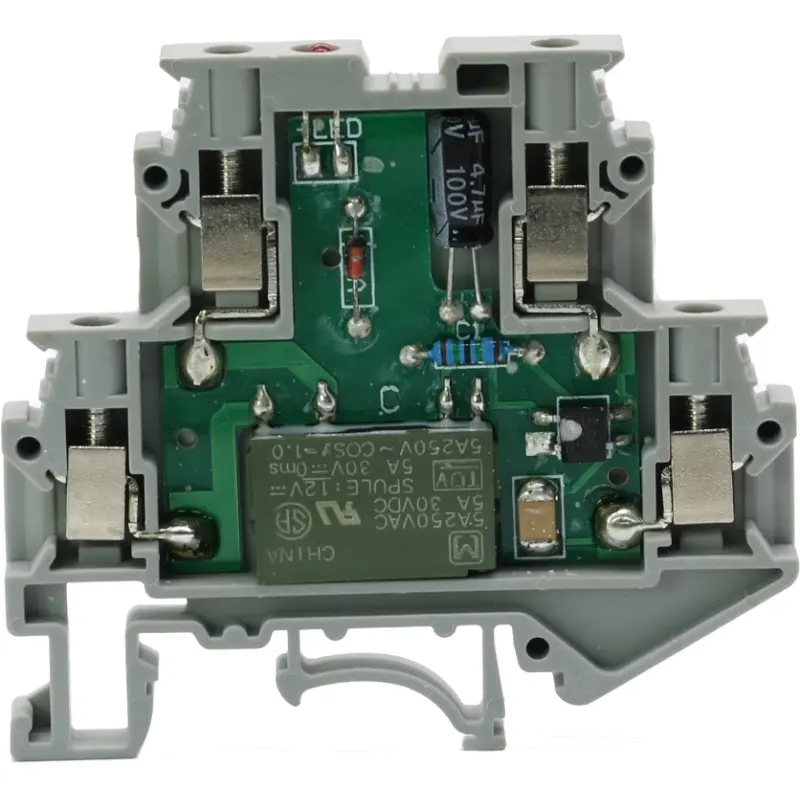In automated control systems, relay terminals and PLC terminals are fundamental components that ensure the stable operation of electrical equipment. Whether it’s relay terminals or PLC terminals, their selection directly impacts the system’s stability, reliability, and maintenance efficiency. To help you make the right choice, this article summarizes the 8 key factors to consider when selecting terminals.
1. Rated Current and Voltage
The first and most basic parameter for selecting normally open relay terminals and PLC terminals is the rated current and voltage. Ensure that the rated current and voltage of the terminal meet or exceed the requirements of the system. Underestimating the rated values could lead to overloads, circuit failures, or equipment damage. Therefore, always check the system’s requirements and the terminal’s rated parameters to ensure safe operation.
2. Terminal Type and Connection Method
Relay terminals and PLC terminals come in various connection methods, such as screw connection, spring connection, and plug-in connection. Each method has its specific application scenarios:
- Screw Connection: Common and reliable, suitable for long-term use with high stability.
- Spring Connection: Convenient for installation and ideal for frequent connections and disconnections.
- Plug-in Connection: Suitable for quick connections and disconnections, especially for device maintenance and replacement.
Choose the appropriate connection method based on your equipment’s specific needs to enhance system stability and operational convenience.
3. Environmental Adaptability
The operating environment of relay terminals and PLC terminals is crucial to their selection. Industrial environments often involve high temperatures, high humidity, dust, and corrosive gases, so it’s necessary to select terminals with good temperature resistance, corrosion resistance, and protective capabilities. For example, terminals should meet IP65 or IP67 protection levels to withstand environmental changes and ensure safe operation.
4. Size and Installation Space
When selecting normally open relay terminals and PLC relay terminals, the available installation space in control cabinets, electrical boxes, etc., should be considered. The terminal’s size, shape, and installation method should match the space in which it will be installed. For equipment with limited space, compact terminals can help maximize space utilization and prevent installation difficulties caused by size incompatibility.
5. Connection Stability and Safety
The stability of the connection between terminals and wires directly affects the safety of the electrical system. To ensure long-term stable operation, the contact surfaces of the terminals should be designed to be firm and wear-resistant, preventing poor contact or loosening. The quality of the terminal material (such as copper, silver-plated, etc.) also determines its durability and transmission stability. Selecting high-quality terminals can significantly reduce faults and maintenance costs.
6. Compatibility
Different brands and models of equipment may use different terminal specifications. It is essential to ensure that the relay terminal and PLC terminal specifications and connection methods are compatible with controllers, relays, sensors, and other equipment. When choosing, make sure the terminals are properly matched with other devices to avoid electrical failures caused by incompatibility.
7. Certifications and Quality Standards
Relay terminals and PLC terminals should meet international or regional safety standards, such as CE, UL, RoHS certifications, etc. These certifications indicate that the product has passed rigorous quality tests and meets electrical safety, environmental protection, and other basic requirements. Choosing terminals with these certifications not only ensures the quality and safety of the product but also reduces risks associated with non-compliant products.
8. Cost-Effectiveness
The cost-effectiveness of terminals is another factor to consider during selection, alongside quality and safety. There is a wide range of terminals on the market, with significant price differences. To avoid choosing unsuitable products based solely on low prices, it’s recommended to select cost-effective terminals that meet technical and safety requirements. In the long run, choosing high-quality terminals can reduce equipment failure rates and maintenance costs, improving overall efficiency.
Conclusion
Selecting the right relay and PLC terminals is crucial for ensuring the stable and efficient operation of electrical systems. In addition to considering basic parameters like current and voltage, it’s important to evaluate other factors such as environmental adaptability, connection stability, and compatibility. By selecting the appropriate terminals, you can ensure both safety and improved system efficiency and ease of maintenance.
If you need further technical support or assistance, feel free to contact us. We are here to provide you with expert selection advice and high-quality relay and PLC terminals to help your automation systems operate more reliably and efficiently.

